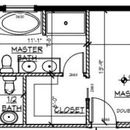New Bathroom Configuration With Shower on Exterior Wall
Hello All! big fan of the site. I am about to start construction on what I would like to call a pretty good home….since i cannot afford to build to passive standards at least i can build better than code. One issue I cannot seem to find a lot of details on is my bathroom configuration. I am in climate zone 4 and my wall profile looks like this: siding/rain screen batts/zip /2×6/blown cellulose/drywall-cement board for bathroom.
Right now I have the walk-in shower on the exterior wall and a stand-alone tub (the tub will not be touching the wall so that should not be an issue)… possible to move it but the ideal location would be on the exterior wall. My whole wall assembly is designed to transport vapor in both directions as we have hot summers and cold winters. By waterproofing with Schluter system and putting up tile am I creating an issue ? I am using intello smart vapour barrier on the ceiling of the house since the attic is going to be vented but, I was just planning on using mesh for the blown insulation on the walls to try to save money as I will be going to nth degree on exterior airtightness (zip tape and liquid flashing)
GBA Detail Library
A collection of one thousand construction details organized by climate and house part











Replies
I wouldn't worry about it. Moisture can diffuse laterally and escape if needed, and unless you take cold showers, that wall will be periodically warmed and thus drive out any moisture.
Your wall is somewhat high risk behind the shower. As you suspected, the tile has very little vapor permeance. Depending on who you talk to, it seems that the OSB layer in ZIP is also relatively vapor-tight, maybe around 1/2 to 1 perm. This means that you must pay strict attention to water management details inside and out to keep bulk water out of the assembly. In Zone 4, you don't have the extremes of vapor drive that you have in very warm or cold climates, so condensation on either side of the wall is less of an issue. The rainscreen helps on the exterior, especially if it is vented top and bottom. Inside, liquid waterproofing on the cement board would be good insurance.
To piggyback on Peter's recommendation, read this:Three Ways to Waterproof a Tile Shower.